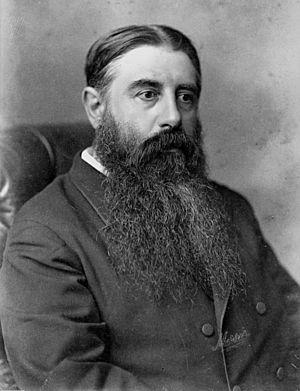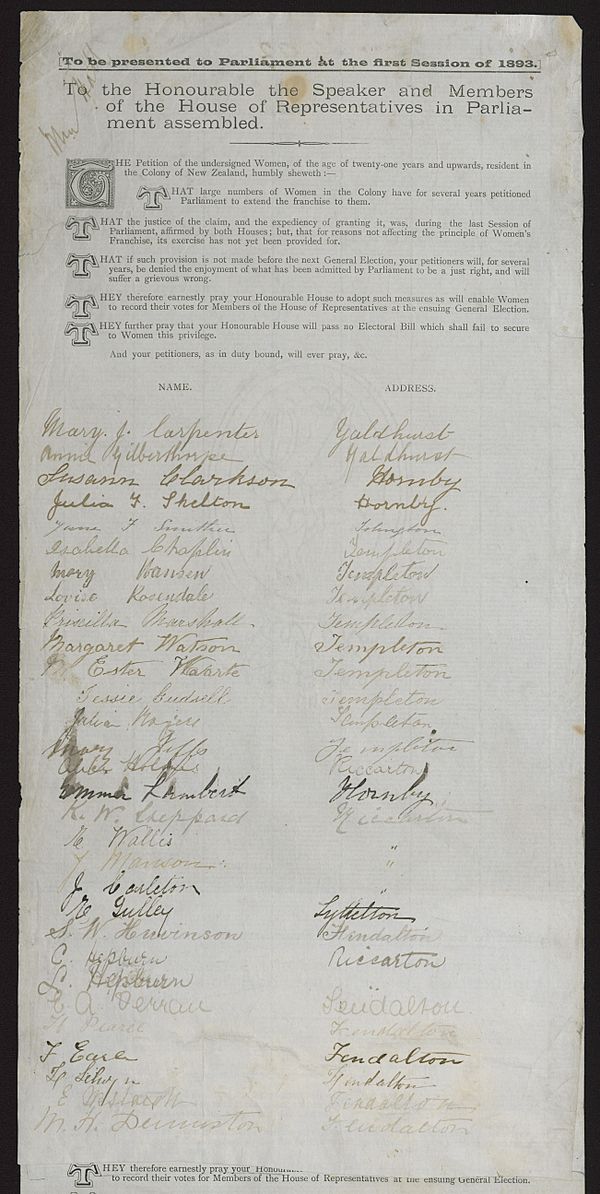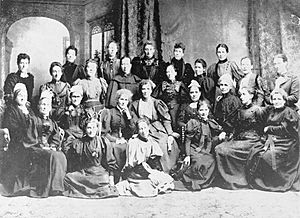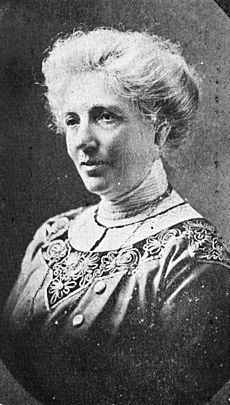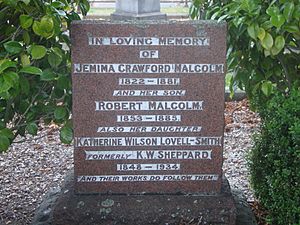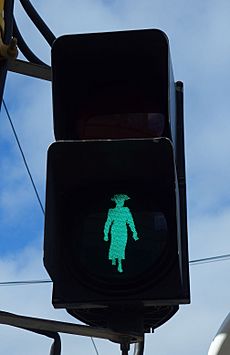Kate Sheppard facts for kids
Quick facts for kids
Kate Sheppard
|
|
|---|---|
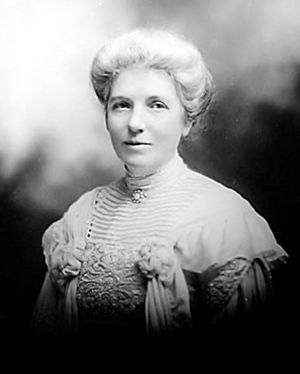
Sheppard photographed in 1905
|
|
| Born |
Catherine Wilson Malcolm
10 March 1848 Liverpool, England
|
| Died | 13 July 1934 (aged 86) Christchurch, New Zealand
|
| Other names | Katherine Wilson Malcolm |
| Known for | Women's suffrage |
| Spouse(s) |
|
| Children | Douglas Sheppard (1880–1910) |
| Relatives | Isabella May (sister) |
Katherine Wilson Sheppard (born Catherine Wilson Malcolm; 10 March 1848 – 13 July 1934) was a very important leader in the women's suffrage movement in New Zealand. She is New Zealand's most famous suffragist, which means someone who fought for women's right to vote.
Kate was born in Liverpool, England. She moved to New Zealand with her family in 1868. There, she became active in many community groups. She joined the Women's Christian Temperance Union New Zealand (WCTU NZ). In 1887, she became the WCTU NZ's leader for voting rights and laws. She used this role to push for women's right to vote in New Zealand.
Kate Sheppard worked hard to get women the vote. She organized petitions and public meetings. She wrote letters to newspapers and talked with politicians. She was also the editor of The White Ribbon, the first newspaper run by women in New Zealand. Her strong writing and speeches helped the cause. Her pamphlets, like Ten Reasons Why the Women of New Zealand Should Vote, were very convincing.
All her hard work led to a huge petition with 30,000 signatures. This petition asked for women's right to vote and was given to the parliament. In 1893, women in New Zealand successfully gained the right to vote. This made New Zealand the first country in the world to allow all women to vote.
Sheppard was the first president of the National Council of Women of New Zealand, started in 1896. She also helped restart the group in 1918. Later in her life, she traveled to Britain to help the women's voting movement there. She returned to New Zealand when her health failed. She continued to write about women's rights until she died in 1934.
Kate Sheppard is seen as a very important person in New Zealand's history. There is a memorial to her in Christchurch. In 1991, her picture replaced Queen Elizabeth II's on the front of the New Zealand ten-dollar note.
Contents
Kate Sheppard's Early Life
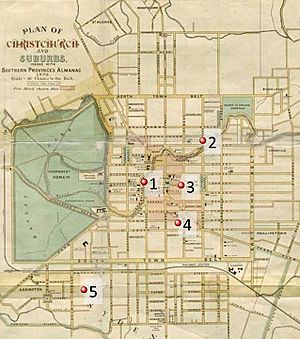
1) Kate Sheppard National Memorial 2) Madras St residence 3) Trinity Church 4) Tuam St Hall 5) Addington Cemetery
Kate Sheppard was born Catherine Wilson Malcolm on 10 March 1848. Her parents, Jemima Crawford Souter and Andrew Wilson Malcolm, were from Scotland. Her father worked as a lawyer or clerk. Kate preferred to spell her name "Katherine" or use "Kate". She had an older sister, Marie, and three younger siblings: Frank, Isabella, and Robert. The family moved often when she was young.
We don't know much about her schooling. However, Kate's later writings showed she knew a lot about science and law. This means she had a good education. She was known for being very smart. Her father loved music, and the family had good music lessons.
Kate's father died in 1862. He left enough money for his family. After his death, Kate lived with her uncle, a minister. He taught her about Christian socialism, which combines Christian beliefs with social justice. The rest of her family stayed in Dublin, where Kate later joined them.
Kate's sister Marie moved to Christchurch, New Zealand, and married George Beath in 1867. Marie's stories about Christchurch made their mother, Jemima, want to move the family there. She hoped her sons would find good jobs and wanted to see her granddaughter. They sailed to New Zealand in 1868 and arrived in February 1869.
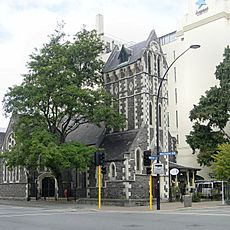
In Christchurch, Kate and most of her family joined the Trinity Congregational Church. Kate became part of Christchurch's smart and social groups. She spent time with Marie and George's growing family.
Kate married Walter Allen Sheppard on 21 July 1871. Walter owned a shop and was elected to the Christchurch City Council in 1868. They lived on Madras Street, close to her mother's home. Kate became friends with Alfred Saunders, a politician who fought against alcohol. He may have influenced her ideas about women's right to vote. Kate and Walter visited England in 1877 for a year. Their only child, Douglas, was born on 8 December 1880.
Sheppard was active in many religious groups. She taught Sunday school. In 1884, she became secretary of the Trinity Ladies' Association. This group visited church members and helped with fundraising. She also worked for the YWCA.
Leading the Women's Suffrage Movement
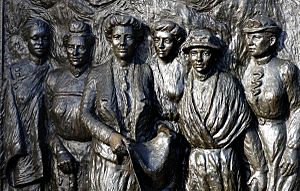
Starting Her Activism
Kate Sheppard started her activism after hearing about Mary Greenleaf Clement Leavitt. Mary Leavitt was from the Woman's Christian Temperance Union (WCTU) in the United States. In 1885, Leavitt visited New Zealand. She spoke about the problems caused by alcohol. She also said that women needed a "voice in public affairs."
Sheppard helped start a WCTU branch in Christchurch. At first, she helped create petitions to stop women from being barmaids. She also wanted to stop selling alcohol to children. She worked with Alfred Saunders, who gave her advice on talking with politicians. These petitions were rejected by Parliament in 1885. Sheppard then realized that politicians would ignore women's requests as long as women could not vote.
In 1879, all men over 21 could vote in New Zealand, no matter if they owned land. But women still could not vote in national elections. However, some women could vote in local elections. In 1873, women who paid property taxes could vote in local elections. In 1877, women who owned homes could vote for education boards.
The New Zealand Women's Christian Temperance Union was formed in 1886. At their second meeting in Christchurch in 1887, Kate Sheppard was ready to talk about women's right to vote. She was first made Superintendent for Relative Statistics. Later in 1887, she became the National Superintendent for the Franchise and Legislation.
Many women supported the WCTU's goal to limit alcohol. They believed that women getting the vote would help them achieve this. But Kate Sheppard's interest in women's voting rights was much deeper. She famously said that "all that separates, whether of race, class, creed, or sex, is inhuman, and must be overcome." Sheppard became a strong speaker and a great organizer. She quickly gained support for her cause.
The WCTU NZ asked Sir Julius Vogel, a Member of Parliament, to introduce a bill for women's voting rights. He did so in 1887 with the Female Suffrage Bill. Sheppard worked hard to support it. The bill failed by one vote. During the election that year, Sheppard encouraged WCTU members to ask politicians about women's voting rights.
In 1888, Sheppard was President of the Christchurch WCTU branch. She gave speeches about voting rights in Dunedin, Oamaru, and Christchurch. She became a confident speaker. To help her message, she gave out leaflets from Britain and the United States. Then, she published her own pamphlet called Ten Reasons Why the Women of New Zealand Should Vote. It showed her clever and logical way of thinking. A copy was sent to every member of the House of Representatives.
Organizing Petitions
In 1888, the government introduced a new Electoral Bill that still did not include women. Sheppard organized a petition to remove this exclusion. She wrote to and met with Sir John Hall, an important Member of Parliament. She asked him to present the petition and support her cause. He did, but nothing happened. Sheppard then wrote another pamphlet, Should Women Vote?. It shared opinions on voting rights from famous people in New Zealand and other countries.
The Electoral Bill was delayed until 1890. On 5 August, John Hall proposed that women should have the right to vote for members of Parliament. After a big discussion, this idea passed with 37 votes to 11. On 21 August, Hall tried to add women's voting rights to the Electoral Bill. But it was defeated by seven votes.
After this defeat, Hall suggested that a petition to parliament should be the next step. Sheppard wrote the words for the petition. She arranged for the forms to be printed. She worked very hard to get people to sign it. During the 1890 election, WCTU members asked all politicians about their views on women's voting rights. The petition had 10,085 signatures. Hall presented it to Parliament in 1891. It was supported by Hall, Alfred Saunders, and the Premier, John Ballance. Hall's amendment to give women the vote passed with a majority of 25 votes.
However, an opponent named Walter Carncross then added an amendment. This amendment would also allow women to become Members of Parliament. This seemed like a good idea, but it was actually meant to make the bill fail in New Zealand's upper house. The bill did fail in the Upper House by two votes.
In 1890, Sheppard helped start the Christian Ethical Society. This was a discussion group for both men and women. The group helped Sheppard feel more confident discussing her ideas with different people. In 1891, Sheppard started editing a page in the Prohibitionist newspaper for the WCTU. She used the pen name "Penelope".
Sheppard promised that a second petition would be twice as big. She worked all summer to organize it. It received 20,274 women's signatures. A politician named Henry Fish paid people to collect two counter-petitions. One was signed by men and the other by women. They received 5,000 signatures in total. In 1892, a new Electoral Bill included women's voting rights. It passed easily in the House of Representatives. But the Upper House wanted women to vote by mail, not in person. Because the two houses could not agree, the bill failed again.
A third petition for suffrage was organized by Sheppard in 1893. This one was even bigger. It had 31,872 women's signatures. This was the largest petition ever given to Parliament at that time.
The 1893 Electoral Bill
The Electoral Bill of 1893, which gave women full voting rights, passed in the House of Representatives in August. Few politicians wanted to vote against it. They feared women would vote against them in the election later that year. So, many chose not to be present during the votes. Henry Fish tried to delay the bill by asking for a national vote. But the bill moved on to the Legislative Council.
After several attempts to stop it failed, the law passed with 20 votes to 18 on 8 September. The bill then needed the Governor's signature. Governor David Boyle did not support women's voting rights. He was slow to sign it, but he finally did on 19 September. Kate Sheppard was widely recognized as the main leader of the women's suffrage movement.
After the 1893 Election
Sheppard had no time to rest. The 1893 election election was only ten weeks away. Newspapers were saying that an early election might be called to reduce the number of women who could register. Sheppard and the WCTU NZ worked very hard to encourage women to register as voters. The main meeting place in Christchurch was the Tuam Street Hall. The liquor industry was a big opponent. They were worried about their businesses.
Despite the short time, 88 percent of women had registered to vote by election day (28 November). Nearly 70 percent of them actually voted. Even though women could vote, they could not become Members of Parliament until 1919. The first woman was elected to parliament in 1933.
Around 1892, Sheppard started riding a bicycle in Christchurch. She was one of the first women in the city to do so. She joined the Atalanta Ladies' Cycling Club. This club was the first women's cycling club in New Zealand or Australia. It caused some debate because some members wore "rational dress," like knickerbockers instead of skirts.
In December 1893, Sheppard was elected President of the Christchurch WCTU branch. She led the first two meetings in 1894. Then, she traveled to England with her husband and son. In England, many women's groups wanted her to speak about how women got the vote in New Zealand. In mid-1895, the WCTU started a monthly magazine, The White Ribbon. Sheppard was the editor, writing for it from overseas. She had health problems in England and needed an operation. The family returned to New Zealand in early 1896. Later that year, Sheppard became editor of The White Ribbon again.
Women's Institutes and the National Council of Women
The Canterbury Women's Institute was formed in September 1892. Sheppard played a key role and led the economics department. This institute was open to both men and women. It worked to reduce unfairness between them. Sheppard believed that getting the right to vote was the first step. It would help achieve other changes, like fair laws about marriage and property.
The National Council of Women of New Zealand was started in April 1896. It was formed by the Canterbury Women's Institute and ten other women's groups. Sheppard was elected president at its first meeting. The Council supported women's right to be in Parliament. They also wanted equal pay and opportunities for women. They worked to remove unfair laws affecting women. They also wanted married women to be financially independent.
Sheppard's election as president caused some disagreements. This, and other issues like whether the Council should support New Zealand in the Second Boer War, led to the organization stopping its work in 1906.
Later Life and Legacy
As editor of The White Ribbon and president of the National Council of Women, Sheppard promoted many ideas. These ideas aimed to improve women's lives and status. She especially wanted women to be legally and financially independent from men. She also supported political changes like proportional representation (fairer voting) and binding referendums (public votes on laws).
Around 1902, Sheppard's marriage seemed to be having problems. Her husband sold their house and moved to England with their son. Sheppard bought new furniture in Christchurch, planning to stay. But in 1903, she sold them and moved to England without a set return date. On her way, she visited Canada and the United States. There, she met the American suffragist Carrie Chapman Catt. In London, she worked to promote women's voting rights. But her health got worse, and she had to stop.
In November 1904, Sheppard returned to New Zealand with her husband. But he went back to England the next year. She moved in with her friends, William Sidney Lovell-Smith and his wife Jennie. She was less active in politics and stopped giving speeches, but she kept writing. She created a display on the history of women's voting rights for an exhibition in Christchurch in 1906. She also wrote a pamphlet called Woman Suffrage in New Zealand in 1907.
The next year, she traveled to England for her son's wedding. She visited the WCTU headquarters in Chicago on the way. She also met with suffrage groups in Britain. In 1912 and 1913, she traveled through India and Europe with the Lovell-Smiths. Her health improved, and she continued to influence the New Zealand women's movement. In 1916, she was the first to sign a petition asking the Prime Minister to urge the British government to give women the vote. In 1918, she helped restart the National Council of Women. Sheppard was elected president that year before stepping down in 1919.
Sheppard's husband Walter died in England in 1915. Jennie Lovell-Smith died in 1924. Sheppard and William Lovell-Smith married in 1925. Lovell-Smith died only four years later. Kate Sheppard herself died in Christchurch on 13 July 1934, at age 86. Her son Douglas had died in 1910, and her only grandchild died in 1930. So, Sheppard had no living direct family members. She was buried at Addington Cemetery, Christchurch, with her mother and brother Robert.
Remembering Kate Sheppard
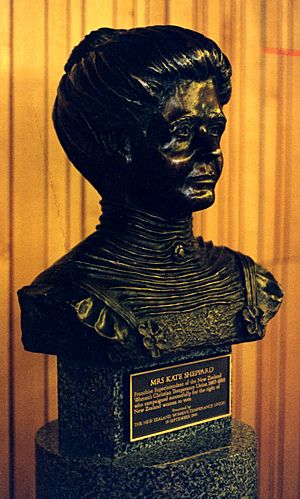
Kate Sheppard is seen as a very important person in New Zealand's history. Since 1992, her picture has been on the New Zealand ten-dollar note. A 2005 TV show called New Zealand's Top 100 History Makers ranked Sheppard as the second most important New Zealander ever. In 2013, The New Zealand Herald newspaper also named her one of their ten greatest New Zealanders.
In 1972, Patricia Grimshaw's book Women's Suffrage in New Zealand said Sheppard was the main leader of the suffrage movement. This book helped people recognize Kate Sheppard's life and work more.
In 1993, New Zealand celebrated 100 years since women got the vote. A group of women in Christchurch created two memorials for Sheppard. One is the Kate Sheppard National Memorial, by the Avon River. The other is the Kate Sheppard Memorial Trust Award, given yearly to women in research. That year, a special white camellia flower was created and named after Kate Sheppard. White camellias were a symbol of the suffragists.
The house at 83 Clyde Road in Fendalton, where the Sheppards lived from 1888 to 1902, is now called the Kate Sheppard House. It is a protected heritage building. Many important events for women's voting rights happened there. It was where Sheppard glued together the three main petitions onto sheets of wallpaper. Kate Sheppard House became government property in 2019.
A New Zealand play called O! Temperance! was written about Sheppard. It was first performed in 1972. In 2016 and 2017, a punk rock musical about Kate Sheppard's life, called That Bloody Woman, toured New Zealand.
Kate Sheppard Place in Wellington, near the parliament, is named after her. It is a short street near Parliament House. There is also a Kate Sheppard Avenue in Auckland. In 2014, eight pedestrian lights near Parliament in Wellington were changed to show Kate Sheppard.
Several New Zealand schools have houses named after Sheppard. In 2014, Whangarei Girls' High School renamed a house that was named after Richard Seddon, who opposed women's voting rights, to Sheppard House. This was done at a student's request.
On 8 March 2018, New Zealand Football renamed its main women's football tournament the Kate Sheppard Cup. This was to celebrate International Women's Day and 125 years of women's voting rights.
Kate Sheppard's Writings
- Should women vote? (1890)
- Woman Suffrage in New Zealand (1907)
- Woman's suffrage petition 1892
See also
 In Spanish: Kate Sheppard para niños
In Spanish: Kate Sheppard para niños


